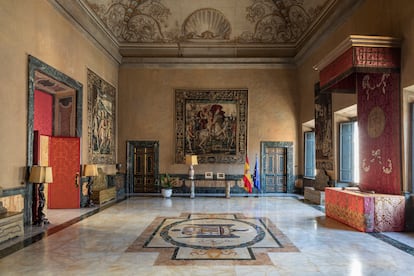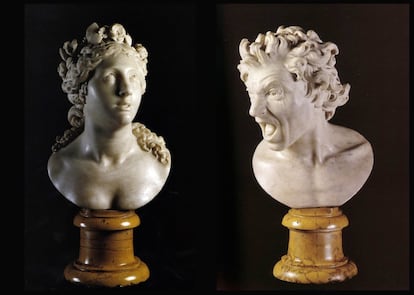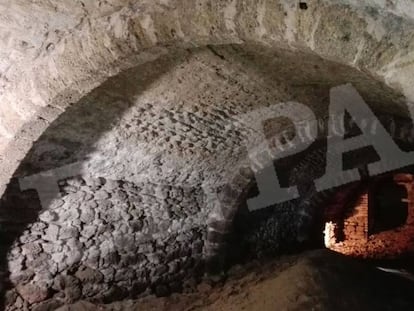A peek inside the oldest embassy in the world
Spain’s diplomatic headquarters before the Holy See, in the heart of Rome, celebrates 400 years in which it has exerted extraordinary influence
The gala dining room of the Spanish Embassy to the Holy See in Rome hosts three fabulous 18th century wool and silk tapestries. They depict scenes from the adventures of Telemachus, made at the Royal Tapestry Factory, based on sketches by Rubens. The tapestries are supposed to recreate the arrival of the son of Ulysses to the island of Ogygia, received by Calypso, a great banquet and, finally, the disagreement and the hasty flight when he realizes the perfidious intentions of Calypso. They are also an illustrative summary of the diplomatic career, some would say: the delivery of credentials, the mundane life in the assigned place and the kick in the butt when they call from the capital to assign a new destination, who knows where. This is well remembered by the 155 different ambassadors who have represented Spain’s affairs before the Holy See, the oldest legation in the world, over the last 400 years.
Every great era has its Cold War. And the one at the time was being waged in the center of the Italian peninsula. It was a battle for control and influence in the greatest spiritual center of the West, which was then in Rome and belonged to the Papal States. Italy and Spain were on opposite sides of that contest. The epicenter of that political, economic and religious battle was halfway up a small Roman hillside. Above were the French. And below, in what would become a definitive conquest, the Spanish. That was when the Catholic Monarchs decided to move the permanent seat of their embassy to the Holy See. A move that allowed the renaming one of the most famous squares in Rome today - Piazza di Spagna, until then called Piazza Trinitatis - and to establish what would be known in today’s parlance as their flagship store.

On Tuesday, Isabel Celaá, the current incumbent, presided over another chapter of the commemorative events that opened earlier this year with an installation by painter Esteban Villalta Marzi. Celaá, Spain’s former minister of education, took up her new post just a few months ago. But the list of ambassadors is long: from Garcilaso de la Vega (senior) to Angel Sanz Briz, known as the Angel of Budapest, who died in the palace in 1980 and whose name appears in the Garden of the Righteous for saving more than 6,000 Jews by issuing false passports when he was Spain’s consul in Hungary. At first, they were called orators, pontiffs who built bridges between one state and another. And one of the first chosen was Gonzalo de Beteta, whom the Catholic Monarchs sent in 1480 to Rome, the arbitrator for 15 centuries of these matters halfway between heaven and earth. In 1622, the Duke of Alburquerque, the first to do so with a fixed seat, moved in. And the decision entailed renting and then buying the Monaldeschi palace, home of the Spanish embassy from that moment. Thus, France and Spain were separated in the center of Rome by a staircase between the Church of Tirinità dei Monti and the new Spanish emblem.
The diplomatic adventure then ran from the hand - and the pocket - of the ambassador on duty. One had to be a nobleman or a great aristocrat to make a full-fledged investment that granted a sort of passport to the Viceroyalty of Naples, as Letizia Rodriguez, personal secretary of Spanish ambassadors for 36 years and one of the people who knows this Baroque palace best, notes as she walks through the rooms of the headquarters. The Count of Oñate bought the building in 1647 for 22,000 Roman escudos of the time (four people could live on four escudos for a month). He then had it completely remodeled by Francesco Borromini. The artist designed the entrance gallery, the vault of the main hall, the courtyard and the imposing square staircase, which broke with traditional schemes. In this way, and after a significant investment, it became something like a royal court, in which the ambassador felt like a monarch in his own right and was even allowed to greet visitors lying on the zampanaro, a kind of bed.

The political and propagandistic dimension of the headquarters was enormous. Beyond baptizing the square with the name of Spain - only two other palaces achieved the same, those of Venice and Florence - the embassy became a fabulous cultural center. Velázquez painted The Forge of Vulcan in what was once the bakery and is now the laundry and a center of cultural patronage. It was mainly during the 17th century and the period of the cardinal ambassadors (Francesco and Troiano Aquaviva) that the embassy attracted guests such as Casanova and, among other things, the chapel was built that still houses the delicate relics of St. Letancio, the incorrupt little body of a boy about nine years old (it has just been checked by a pathologist who has confirmed that everything is still in order), a martyr of Carthage in the year 180. A gift from Pope Clement XI, the relics might seem somewhat disturbing today, but at the time they were an extraordinary present. Today, too, they seem so in the midst of a sobriety that is broken only by the occasional parties organized by the cultural advisor on duty, traditionally located in the premises of this embassy.
Most of the rooms - with the legend of the ghost Friar Piccolo included - are lined with the fabric still woven by a factory in Caserta for Buckingham Palace and the White House. The heritage accumulated among those red quilts is incalculable, although there is little doubt that the two works sculpted by a young Bernini in 1619, Condemned Soul and Saved Soul, are the pinnacle of the embassy. The two busts rest in a room accessed through the collection of 36 Flemish, French and Italian tapestries - three of them from 1522 - deposited in 1921 by Antonio de Orleans Bourbon, Duke of Galiera, with this note: “To keep them from bad-faith creditors.” That is, so that they would not be seized over debts.
The Church’s unit of measurement is the century, but the mission to the Holy See will continue to celebrate its fourth centenary in the remaining months of the year. When everything passes, its walls will continue to see all kinds of diplomats and ambassadors, who will perhaps feel like monarchs, but for whom it would be convenient to carefully observe that triptych of Telemachus and Calypso to remember that in Rome, most of them are just passing through.
Tu suscripción se está usando en otro dispositivo
¿Quieres añadir otro usuario a tu suscripción?
Si continúas leyendo en este dispositivo, no se podrá leer en el otro.
FlechaTu suscripción se está usando en otro dispositivo y solo puedes acceder a EL PAÍS desde un dispositivo a la vez.
Si quieres compartir tu cuenta, cambia tu suscripción a la modalidad Premium, así podrás añadir otro usuario. Cada uno accederá con su propia cuenta de email, lo que os permitirá personalizar vuestra experiencia en EL PAÍS.
¿Tienes una suscripción de empresa? Accede aquí para contratar más cuentas.
En el caso de no saber quién está usando tu cuenta, te recomendamos cambiar tu contraseña aquí.
Si decides continuar compartiendo tu cuenta, este mensaje se mostrará en tu dispositivo y en el de la otra persona que está usando tu cuenta de forma indefinida, afectando a tu experiencia de lectura. Puedes consultar aquí los términos y condiciones de la suscripción digital.
More information
Últimas noticias
The metaverse, four years later: Is it finished or just at a standstill?
$3,000 and a plane ticket: The United States increases incentives for migrants to self-deport before the end of the year
Charles Dubouloz, mountaineering star, retires at 36 with a farewell tour inspired by Walter Bonatti
From the White House to diplomatic gifts: Lego wins over adult fans, brick by brick
Most viewed
- The low-cost creative revolution: How technology is making art accessible to everyone
- Families demand repatriation of bodies of Colombians who died in Ukraine: ‘This war is a slaughterhouse for foreigners’
- Christian Louboutin: ‘Young people don’t want to be like their parents. And if their parents wear sneakers, they’re going to look for something else’
- All the effects of gentrification in one corner of Mexico’s Colonia Roma
- Christmas loses its festive spirit: ICE fears cast shadow over religious celebrations











































